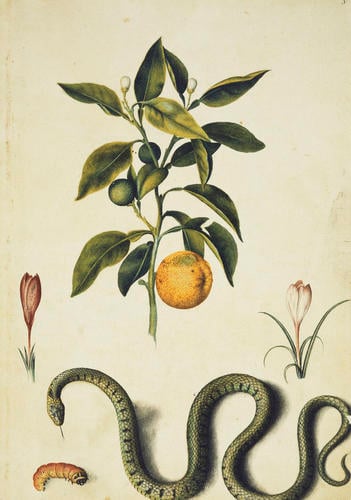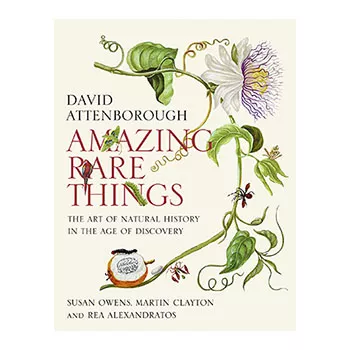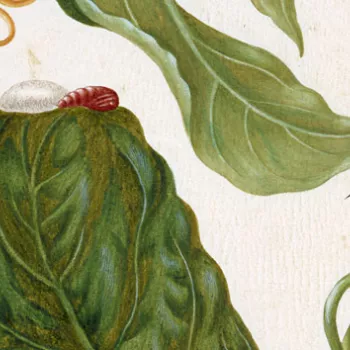Seville orange, purple crocuses, grass snake and goat moth caterpillar c. 1650-82
Watercolour | 46.0 x 33.3 cm (sheet of paper) | RCIN 924270
-
A watercolour depicting a Seville or bitter orange (Citrus aurantium L.) with dark leaves, buds green and ripe fruit, two purple crocuses (Crocus vernus Hill and Crocus vernus Hill ssp. albiflorus) showing leaves and flowers, a North-western European grass snake (Natrix natrix) and a Goat moth larva (Cossus cossus).
Alexander Marshal was a talented horticulturalist, entomologist and amateur artist. He was one of a network of gardeners working in and around London in the middle of the seventeenth century, and had links with the Tradescants (who had a garden at Lambeth) and Henry Compton (who, as Bishop of London, developed a fine garden at Fulham Palace). Marshal’s careful study of plants was combined with an examination of the science of painting and he wrote in 1667 to the Secretary of the Royal Society to discuss the methods he used for making pigments: ‘I thought Seven years agon [ago], that I Knew much, but I find, that practice shows me daily more than I Knew before…. the Searche of Colours has Cost me much time in finding out, and to know, which would hold Colour in water, and mixe well, else I had not used them in my booke, and am shure will bee as fresh a hundred years hence, as when you Saw them Last.’ The colours in Marshal’s paintings do indeed remain impressively bright over 350 years later.This is folio 3 of Marshal’s Florilegium, which he painted entirely for his own pleasure. Marshal worked on the volume over a long period, from at least the 1650s to the late 1670s. The Florilegium is formed of 159 folios, depicting around 650 flowers (of around 284 different species). As is standard in such compilations, the plants are arranged by season. This is not the only book of natural history drawings compiled by Marshal: he also compiled a florilegium for John Tradescant (untraced) and a set of notes and drawings of insects (now in the Academy of Natural Sciences, Philadelphia).After Marshal’s death, his Florilegium passed to his nephew, Robert Freind. It remained in the Freind family, and was listed among the collection of Dr William Freind (1715-66), Dean of Canterbury, in the eighteenth century. In his list, Freind noted that Catesby ‘had an independent fortune and painted merely for his Amusement. - He is said to have had a particular art of extracting Colors out of the Natural Flowers; and some of the Plants and Flowers contained in this Volume are painted with those Colors’. Freind’s collection, including the Florilegium was sold by auction in 1777. In 1818, the Florilegium was acquired John Mangles of Hurley, Berkshire, who presented it, at an unknown date, to George IV.The plants and animals in the present sheet were identified by Marshal on the verso as, respectively,: 'Mala Arantia / orange', 'Crocus', 'Crocus', 'English [snake]'. The larva was unnamed. In William Freind's catalogue, this sheet was described (f.129) as '3. Snake and Caterpiller (large as the life) - Sprig of an Orange-Tree. Two red Crocus.' The Seville orange was first grown in England in the late sixteenth century. Specially constructed orangeries, providing shelter and warmth for the trees in winter, began to be developed in the early seventeenth century.For further information and identification of the species depicted see Prudence Leith-Ross, with Henrietta McBurney, The Florilegium of Alexander Marshal in the Collection of Her Majesty The Queen at Windsor Castle (2000).Provenance
The artist; on his death in 1682, passed to his widow, Dorothea (d.1711); bequeathed to her nephew Dr Robert Freind (1667-1751); perhaps (according to an account by James Douglas) passed to his brother Dr John Freind (1675-1728); passed to Dr William Freind (1715-1766), son of Robert Freind; his sale (Messrs Christie and Ansell) 25 April 1777, lot 46, where purchased by a Mr Way (perhaps Benjamin Way, FRS, FSA); by 1818 in Brussels, where purchased by Ross Donnelly for John Mangles of Hurley, Berkshire. Presented by John Mangles to George IV at an unknown date.
-
Creator(s)
Acquirer(s)
-
Medium and techniques
Watercolour
Measurements
46.0 x 33.3 cm (sheet of paper)
Object type(s)
Other number(s)
RL 24270










